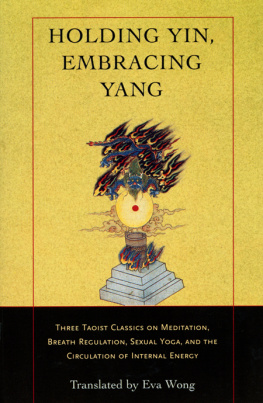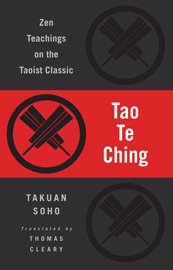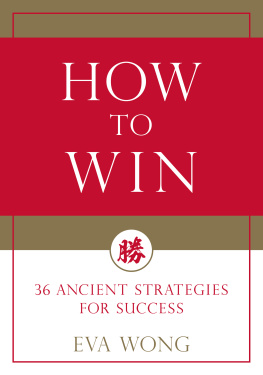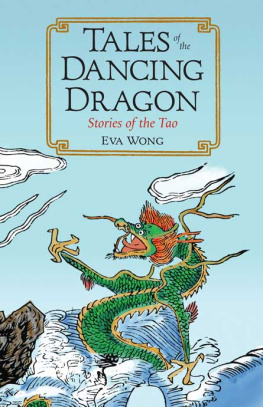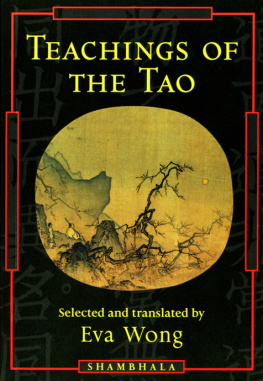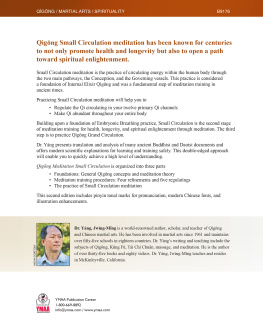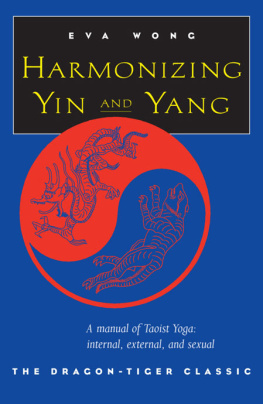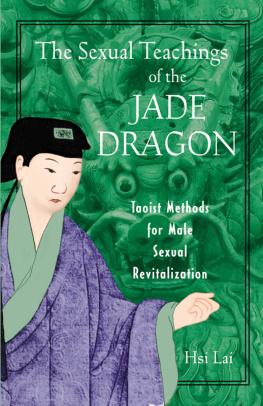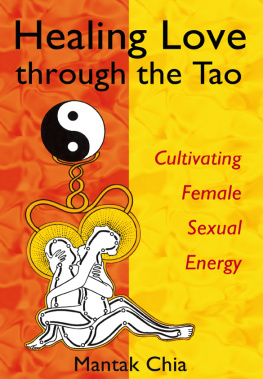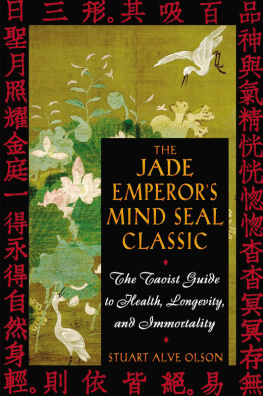ABOUT THE BOOK
In Holding Yin, Embracing Yang, Eva Wong presents translations of three key texts containing the highest teachings of the Eastern and Western schools of Taoist internal alchemythe discipline of cultivating health, longevity, and immortality by transforming the energetic structures of body and mind. The texts are primarily concerned with meditation, breathing practices, and sexual yoga with a partnerall as means for developing within ourselves the same life-giving energy that sustains and nourishes the universe.
The texts in this collection offer a clear view of the physical, mental, and spiritual methods of Taoist practice, showing why they are important and how these methods all can work together in the cultivation of mental peace, radiant health, and longevity. This collection will provide inspiration and the essential foundation necessary to begin Taoist practice under the guidance of a teacher.
The three classics translated here are: Treatise on the Mysterious Orifice by Xuanweilun (sixteenth century), Discussion on the Cavity of the Tao by Daojiaotan (nineteenth century), and Secret Teachings on the Three Wheels by Sanjubizhi (nineteenth century). Included is an introduction in which Wong discusses the various schools of internal alchemy, as well as their main practices.
EVA WONG is an independent scholar and a practitioner of the Taoist arts of the Pre-Celestial Way and Complete Reality lineages. She has written and translated many books on Taoism and related topics, including A Master Course in Feng-Shui; Tales of the Taoist Immortals;The Tao of Health, Longevity, and Immortality; and The Shambhala Guide to Taoism.
Sign up to learn more about our books and receive special offers from Shambhala Publications.

Or visit us online to sign up at shambhala.com/eshambhala.
Holding Yin, Embracing Yang

THREE TAOIST CLASSICS ON MEDITATION, BREATH REGULATION, SEXUAL YOGA, AND THE CIRCULATION OF INTERNAL ENERGY
Translated with an introduction by
Eva Wong

SHAMBHALA
Boston & London
2012
Shambhala Publications, Inc.
Horticultural Hall
300 Massachusetts Avenue
Boston, Massachusetts 02115
www.shambhala.com
2005 by Eva Wong
COVER ART: Golden Elixir, from the Qing dynasty handscroll Jinye huandan yinzheng tu, circa seventeenth or eighteenth century. Used by permission of White Cloud Monastery, Beijing.
All rights reserved. No part of this book may be reproduced in any form or by any means, electronic or mechanical, including photocopying, recording, or by any information storage and retrieval system, without permission in writing from the publisher.
Library of Congress Cataloging-in-Publication Data
Holding yin, embracing yang: three Taoist classics on meditation, breath regulation, sexual yoga, and the circulation of internal energy / Translated with an Introduction by Eva Wong.1st ed.
p. cm.
eISBN 978-0-8348-2431-7
ISBN 978-1-59030-263-7 (pbk.: alk. paper)
1. Taoism. 2. Hygiene, Taoist. I. Wong, Eva, 1964
BL1920.H65 2005
299.5148dc22
2004024705
Contents

The texts in this collection were chosen to highlight the Taoist practices of meditation, breath regulation, the microcosmic and macrocosmic circulations, and sexual (consort) alchemy. The Treatise on the Mysterious Orifice (Xuanweilun) was written by Lu Xixing (15201606); both the Discussion on the Cavity of the Tao (Daojiaotan) and Secret Teachings on the Three Wheels (Sanjubizhi) were lectures by Li Xiyue (18061856) compiled by his students.
The practices of meditation, breath regulation, the microcosmic and macrocosmic circulations, and sexual yoga are methods of Taoist internal alchemy. Internal alchemy is the discipline of cultivating health, longevity, and immortality by transforming the energetic structures of body and mind. Today, there are four recognized schools of Taoist internal alchemy: the Northern, Southern, Eastern, and Western schools, named after the geographic regions of China where they originated.
THE NORTHERN SCHOOL
There are two branches of the Northern school. The first branch is the Northern Complete Reality school (Beiquanzhen), founded by Wang Chongyang; the second is the Pre-celestial Limitless sect (Xientienwujimen), founded by Chen Xiyi. Both schools originated in the Song dynasty (9601279 C.E.); both taught that mind should be cultivated before body, and neither uses techniques of sexual alchemy. The teachings of the Northern Complete Reality school are best represented by the Dragon Gate (Longmen) sect. This monastic sect was founded by Wang Chongyangs student Qiu Changchun. The Pre-celestial Limitless sect of Chen Xiyi is a nonmonastic hermit lineage, its teachings transmitted orally from master to student. Practitioners of both branches of the Northern school are usually initiated into the lineage when they are young. (Qiu Changchun himself was a teenager when he began his spiritual training.) This probably explains why the Northern school favored techniques of the single path (practicing without the help of a consort). Since little to none of their generative energy was lost, the practitioners need not replenish their energy by gathering it from a partner. Today, there are Dragon Gateaffiliated monasteries worldwide, but the influence of Northern Complete Reality Taoism is still strongest in northern China. The influence of the Pre-celestial Limitless sect is less easy to document because of its hermit lineage, but small groups of its practitioners are found throughout mainland China, Taiwan, and Hong Kong. (More information on the teachings and practices of the Northern Complete Reality school and the Pre-celestial Limitless sect can be found in my Shambhala Guide to Taoism, Cultivating Stillness, Cultivating the Energy of Life, and Nourishing the Essence of Life.)
THE SOUTHERN SCHOOL
The southern branch of the Complete Reality school, the Southern school not only taught that body needs to be cultivated before mind, but also uses techniques of sexual yoga (the paired path). Although Zhang Boduan of the Song dynasty is acknowledged as the founder of this school, the division within the Complete Reality school already existed during the time of his teacher Liu Haichan. Both Liu Haichan and Wang Chongyang had studied with Lu Dongbin, the patriarch of modern Taoist internal alchemy. While Wang favored the single path, probably because of his Confucian and Chan Buddhist influences, Liu and Zhang both tended to be pragmatic and taught single or paired practice according to the needs of their students. This is probably because they both started Taoist cultivation late in life and understood how paired practice could help older students. There are several important differences between the Southern Complete Reality school and its northern counterpart. First, the southern branch is not monastic. Second, most of its practitioners tended to be householders who had raised families before studying the arts of longevity. Having lost much generative energy over the years, these practitioners needed a quick way to replenish it. Sexual alchemy, or paired practice, allowed them to do exactly that. The Southern school considered the paired path a matter of convenience, its techniques useful for replenishing generative energy in the early phases of cultivation. Once generative energy is plentiful, practitioners will switch to techniques of the single path. Third, because it is a lay tradition, the Southern school was and still is a loosely knit group of practitioners led by independent teachers. Spread over the areas south of the Yangzi River, practitioners of the Southern school follow teachers who often added personal touches to the teachings. Eventually, some of these personal touches evolved into distinct lineages. One was the Eastern school of Lu Xixing, and the other was the Western school of Li Xiyue.
Next page
